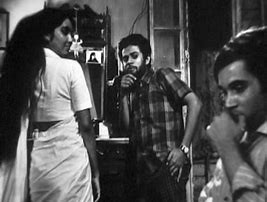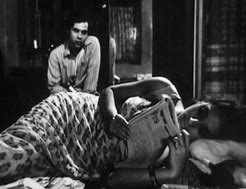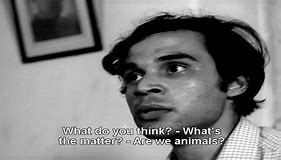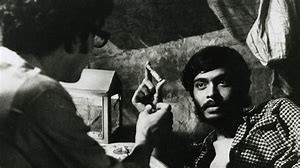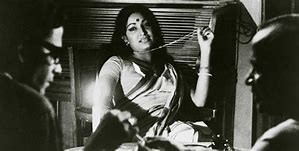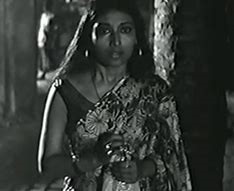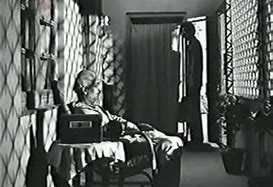Encounters with the Forbidden: Satyajit Ray’s Pratidwandi and Jana Aranya
Skip other details (including permanent urls, DOI, citation information)
: This work is licensed under a Creative Commons Attribution-NonCommercial-NoDerivatives 4.0 International License. Please contact mpub-help@umich.edu to use this work in a way not covered by the license.
For more information, read Michigan Publishing's access and usage policy.
Abstract
In Pratidwandi/The Adversary (1970) and Jana Aranya/The Middleman (1975), Satyajit Ray focuses on the Bengali middle class and makes sexual repression his subject, placing his male protagonists in situations where they encounter the forbidden: That which is not socially and culturally sanctioned and, therefore, deemed unacceptable. The setting is Calcutta of the 1970s—a city in social and political turmoil where his young men struggle to hold onto their cherished ideals and values. Ray describes a series of interactions with women whose otherness—sexual and otherwise—generates paradoxical feelings of attraction and repulsion, desire and fear. He also offers a critique of how men construct women in sexist and degrading terms which often relates to their inability to act on the promptings of their desires.
Satyajit Ray’s Calcutta trilogy consists of Pratidwandi/The Adversary (1970), Seemabaddha/Company Limited (1971) and Jana Aranya/The Middleman (1975) —all set in Calcutta (now Kolkata) during the turbulent 70s when India was in the throes of major political upheavals. There was the Bangladesh war, the exodus of refugees, large-scale government repression, and the declaration of a nationwide Emergency. When the Naxalites, a Maoist group, called for armed revolution, Calcutta turned into a city of daily rallies, bomb blasts, and killings. As a critic writes:
In 1969...the adult world in Bengal was up in flames. The Calcutta of the burning trams, never seen in Ray's work, had turned into a conflagration. Murders were taking place everyday, pipe guns and bombs were common sights and sounds...[1]
The trilogy, made against this background, is a filmmaker’s anguished cry at the debasement of a whole culture. In it he portrays a city without hope, where corruption is rampant, jobs are rigged, women walk the streets and the unemployed stare vacantly into space. His middle class protagonists—all young men—are the victims of a dehumanizing rat race, struggling to hold onto their inherited values in the face of betrayal and compromise. Having grown up in a very different era, Ray embarks on “a search for identity” with this generation and the world they inhabit in order to “understand them...or discover his relationship with them.”[2] Accordingly, he places the Bengali male within the multiple social, cultural, and political contexts of his urban milieu which define him at a time of radical change when he is most vulnerable. One such context is sexuality and its articulation which Ray addresses in Pratidwandi and Jana Aranya. In both films, he examines the legacy of established conservative beliefs which often come into conflict with the forces that are transforming society, reframing ideas and concepts, and reconfiguring gender roles. Thus, the shifting urban landscape of the 70s provides Ray with an opportunity to delve into a subject which, like so much else during this troubled, unpredictable time, is fraught with ambivalence and contradiction, uncertainty and paradox.
Both of Ray’s protagonists—Siddhartha and Somnath—cannot quite shake off the yoke of their traditional upbringing which has taught them to repress their libidinal longings. In fact, in Pratidwandi, Siddhartha is accused by a friend of desiring women but lacking the guts to initiate such desire. “He’s hungry all right, but won’t show it on his face” is his verdict, alluding to a social and cultural phenomenon which he attributes to most Bengali middle class men. Sexual diffidence and repression, he implies, are the lot of males from such a class, whose roots lie within the Bengali home, governed by a stifling orthodox morality imposed by fathers on their sons. Sons are expected to grow up into “proper” respectable young men, live up to their parents’ expectations and fulfill their family obligations which entail doing well in their studies, finding a job, accepting a marriage arranged by their parents (whose injunctions they cannot disobey), and dutifully producing a male heir. In such households, sex is taboo as a subject of common discourse, never articulated by any of the family members unless an unexpected scandal rocks the home from within or without. Similarly, the function of sex within marriage is to keep the family line alive. Men thus grow up inhibited and unfulfilled with a warped sense of sexuality.
In both films, Ray deals with the effects of such repression in a mutating world, placing his male protagonists in situations where they increasingly encounter the forbidden—that which is not socially or culturally sanctioned and, therefore, deemed unacceptable. These encounters invariably feature women, who faced with the challenges of a crumbling social system, have either willfully rejected the patriarchal dictates of their class or been forced to recast themselves in roles which involve compromising their morals (both films feature prostitutes). It is their otherness, sexual and otherwise, which men find seductive and, at the same time, bewildering and deeply alienating. Thus, their interactions with such women—both allure and threat—generate paradoxical feelings of attraction and repulsion, desire and fear. They see them as transgressors who have openly defied the ethical standards of their society, thus aligning themselves with the forbidden and the sordid. And yet this very fact adds to—even increases—their appeal. Are they to be then courted or shunned? In Siddhartha’s case, we see confusion and vacillation when he is in such company and an unfortunate rejection of his rebellious sister for whom his feelings could be construed as more than brotherly. Somnath, on the other hand, overcomes his initial doubts and misgivings and displays a solid pragmatism which he believes is his only course of action. In both cases, what is disturbing is their construction of women often in sexist and degrading terms. This stems not merely from their legacy as men in a patriarchal culture but from an inherent powerlessness based in their failure to act on the promptings of their desires. Thus both men are exposed as weak, even pathetic, in their encounters with the forbidden.
Pratidwandi: A Failure of Nerve?
Siddhartha, in Pratidwandi, is a young man of twenty-five who gives up his medical studies when his father dies and starts looking for a job around which the film revolves. His younger brother, Tunu, a college student and radical left-wing political activist talks revolution all the time. Sister, Sutapa, younger by a few years, is the sole bread-winner in the family (which includes their mother and an uncle). Returning home every night, for Siddhartha, is like entering an airless, claustrophobic cell where there is only despair and hopelessness. The only positive development in his life occurs in the second half of the film when he meets Keya and their friendship blossoms into love for she alone can relate to his sensitive nature. The film ends with an interview during which Siddhartha explodes with anger at the sheer callousness displayed by the authorities. Forced to leave his city, he accepts a job as a medical representative in a small town.
Ray turns Siddhartha into a brooding, introspective man with a smoldering vitality that often breaks out in flashes of anger. A deeply troubled man, who has “a lot of things going on in his head,” his vacillations and inner contradictions extend to all spheres of his life and point to a core of insecurity within.[3] Like most young men of the 70s, Ray shows him plagued by recurring self-doubts which prevent him from acting with a clear sense of focus. He shoots him often with his arms folded, hugging his body in a posture of vulnerability, occupying the space where two walls intersect. This middle space, when translated into the film's narrative, becomes a metaphorical threshold from which he needs to step forward. Instead, Siddhartha falters and often indulges in fantasies and daydreams rather than face reality: the reality of his desires as well as the challenges life throws up at him. As Darius Cooper remarks, Siddhartha is “constantly escaping into his inner space.”[4]
Early in the film we get a sense of this tendency in a quasi-sexual context when Siddhartha’s gaze falls on a well-endowed woman crossing the street. Whatever libidinal impulses he may feel are quickly disarmed and deflected via a flashback to a class he attended as a medical student. As we see the professor lecture, using a slide of the female breast, we realize how the inhibited Siddhartha refuses to confront the feelings the woman arouses in him, feelings which he has been taught to repress as forbidden.
A more serious challenge is posed by his former classmate, Adinath, when he takes him to meet his female “friend” without any forewarning that she works as a part-time prostitute. Adinath calls himself a “doer” as opposed to a “thinker” and believes that the end justifies the means. Not bothered by any ethical compunctions—since nobody seems to care for them anyway—he displays an amoral, ultra-pragmatic attitude that allows him to grab every self-serving opportunity. It is he who will later accuse Siddhartha of fear and timidity, especially when it comes to women, seeing him as a spineless male, trapped within his middle class legacy, unable to take advantage of the times in which he lives.
Sure enough, even before he sets eyes on the woman who will embody his first real encounter with the forbidden, Siddhartha complains of feeling confused. His sense of insecurity on entering a new and alien space is palpable. Inside the big, crumbling house carved into dismal flats, children play on the landing and shout "Ready, steady, go!" but Siddhartha is reduced to a state bordering on mental and physical paralysis.
Ray shoots the sequence that follows mostly in tight medium shots often keeping the three characters in frame. However, by placing Siddhartha occasionally in the background of the image, with his reflection in a dressing table mirror which the woman faces, he also separates him from the group and establishes his sense of profound unease. Adinath’s friend who works as a nurse during the day is one of those individuals (there will be several in Jana Aranya) who conceal their otherness behind a facade of normalcy. Such “doubleness”—as we will see—can be deeply disorienting. At first, the friendly, smiling woman who welcomes them in seems no different from most middle class women Siddhartha is familiar with. However, as she speaks in a flirtatious, even mocking tone, the mask begins to slip and his “nightmare of doubt begins.”[5] While describing her day's work, she wishes her crabby 80-year-old patient would die, her heartless indifference further alienating her from Siddhartha’s world. But the most blatant display of her otherness occurs when, open to the men's gaze, she proceeds to take off her clothes. Such an unabashed rejection of middle class propriety is both socially and sexually threatening for Siddhartha. He sits white-faced in his chair, refusing to make eye contact with this creature that fills him with dread, the dread of emasculation. His reflection in her mirror describes his unreal, liminal state, thrust into her domain but occupying, as usual, a middle space which translates into a crippling non-space of action.
Still averting his eyes, he somehow manages to provide her with a cigarette (at Adinath’s bidding). When he strikes a match and she leans forward toward him, Ray switches to negative to underline this moment of extreme dislocation. For Siddhartha, the tentative physical contact is utterly repulsive as is Adinath’s exhortation, "She's all yours, brother!" (he had earlier paid her money from his wallet which Ray had shot in close-up). When the latter disappears into the bathroom with the nurse, he stalks out in apparent disgust while the children outside chant, "Ready, steady, go!"
For Adinath, Siddhartha's failure to act is simply a loss of nerve, an inability to translate desire into practice which points to his tragedy as a middle class male. But Ray also suggests that Siddhartha is morally outraged since he finds the whole business utterly revolting and that his reaction is much more complex than it seems at first. In fact, seen from this perspective, Siddhartha is part of Ray’s larger critique of the degradation of women in the 70s, forced into prostitution to supplement their meagre income, who sadly become prey for men like Adinath. In this respect, Siddhartha’s refusal of sex is laudatory but Ray wants us to take into account Adinath’s point of view as well as the urging of the children to just “go.” And he wants us to question Siddhartha’s moral stance: Is it grounded in real, solid values or merely a face-saving posture? We will see how other motives can be imputed later once Siddhartha’s relationship to his sister, Sutapa, is established.
A Brother’s Prurient Gaze
Perhaps more than anyone else in Ray's cinema, Sutapa embodies the new, career woman of the 70s. Good-looking with material ambitions, she is bent on furthering her professional life even if it means reciprocating the sexual advances of her boss. She seems unfazed about the “scandal” that has rocked her home and deeply upset her mother. In her rejection of middle class morality and the role created for her by her class, she maintains her independence without any regrets for daring to be different. While Ray seems to support her bid for autonomy, he is concerned about the moral price tag that is attached to such an aspiration. Although financially better off than the nurse-prostitute, she, too, has succumbed to the allure of lucre which her boss shrewdly exploits.
Ray repeatedly associates her with her dressing table mirror in which she likes to gaze at herself, mostly in medium shot. There is no apparent guilt or self-effacing modesty about such self-indulgence which borders often on exhibitionism. We learn that she wishes to be a model and that she is learning to dance; activities which alienate her further from her class but which display her confidence in her body and sexuality. The more we see her preening before the mirror and lolling on the bed (instead of helping with the housework like a dutiful daughter), the more her pleasure-and-ego-driven nature becomes evident within its context of otherness. As Andrew Robinson remarks, Sutapa is “more interested in clothes, make-up, modelling and having a good time than in family prestige.”[6]
Since we always see Sutapa in relation to Siddhartha and often from his point of view, she comes to occupy a central place in the discourse on sexuality which involves him intimately. His evident pleasure in fixing his gaze on her is amply demonstrated in the film. As we watch her watching herself in the mirror, we see him watching her as she arranges her sari, lets down her hair, and engages in one of her exhibitionistic reveries. Ray often overlaps his reflection over hers in the mirror thus joining together subject and object with regard to the gaze. Such obsessive voyeurism is unsettling and suggests more than brotherly concern or curiosity. In fact, it comes dangerously close to the forbidden, prurient gaze of a brother for his sister.
Ray suggests that it is only within the reassuring, familial space of the middle class home that an inhibited Bengali male, such as Siddhartha, who is increasingly aware of his own failings and his growing estrangement from the world outside, will engage with his libido. In this case, such an indulgence results in a pathetic projection of his repressed longings onto the person who is closest to him, Sutapa. Her desirability is enhanced paradoxically through her liaison with her boss which links her to a sexuality that is socially unacceptable and, thus, forbidden. It adds to her appeal, otherness, and “availability” for sexual solicitation while, at the same time, turns her into a threatening figure for the insecure Siddhartha. She thus provokes in him a contradictory attraction and repulsion, mediated by fear.
But there is more. For Siddhartha, such thoughts and feelings for his sister—morally contemptible in his society—generate terrible guilt and anxiety. To free himself from the remonstrations of his conscience, he conflates Sutapa with the woman who fills him with disgust, the nurse-prostitute. Designated “whore,” Sutapa ceases to be a threat since she can be dismissed as corrupt and depraved, the instigator of illicit desire in her “respectable” brother. Thus by making her the source of such desire and, that too, in the most degrading terms, Siddhartha, can no longer be guilty of harboring “forbidden” feelings for his sister.
Accordingly, there are a number of correspondences between the scenes featuring Sutapa and Siddhartha and those featuring Siddhartha and the nurse-prostitute to establish the analogies he wishes to create. We are reminded immediately of Sutapa’s narcissistic self-displays when we later witness the prostitute’s own exhibitionism as she loosens her hair before her dressing table mirror, glances at her reflection and undresses.. Both scenes are linked to Siddhartha's point of view because he brings the two women together in his mind. When the prostitute sheds her sari and appears in her underclothes, she seems to enact what Sutapa had insinuated through the seductive rearranging of her sari in front of him. In other words, his sister’s subtle “foreplay” is made real by the prostitute. When the latter asks for five minutes to freshen up and heads for the bathroom, the parallel with Sutapa is reinforced for she too had said and done the same earlier.
There are more correspondences. As she poses in front of her mirror while Siddhartha watches, Sutapa speaks of her ambition to be a fashion model even if it entails wearing a skimpy outfit. Although he pretends to be shocked, we see him fantasize her as one—glamorous and attractive—in a brief montage of shots, thus drawing an analogy between sister as model paid to display her body and the prostitute displaying hers for sex in exchange of money.
Thus, through such comparisons, Siddhartha engages in a pathetic degradation of Sutapa to appease his own conscience. And the process is completed via a dream in which girlfriend Keya appears to restore "normalcy" since she is everything Sutapa's not: asexual, non-aggressive, non-materialistic, and, above all, non-threatening. In fact, she fits the prototype of the respectable middle-class Bengali woman with whom Siddhartha can feel "safe." She thus replaces Sutapa in Siddhartha’s dream.
The dream begins as an anxiety dream strewn with emblems of Siddhartha’s guilt, insecurity, confusion, and failure. It also offers a shorthand version of recent events in his life, some shot in negative and intercut with his reaction shots. The two most prominent figures are Sutapa modeling in a one-piece swimsuit and brother Tunu facing a police firing squad for his political activities. Ray composes these shots mostly with a slow tracking camera to simulate Siddhartha’s drifting, abbreviated memories, and thoughts. As Tunu is shot dead, Sutapa in a nurse’s uniform (thus equated with the prostitute) bends over the corpse as Siddhartha looks on. There is next a sudden switch in identity and Sutapa becomes Keya. The dream ends with a puzzled Siddhartha asking Keya, “It’s you?”
Tunu's death marks the turning point of this anxiety dream as it brings together the three women who have recently figured in Siddhartha's life. In a neat compression, the swimsuit-clad Sutapa, who embodies his desire and guilt, becomes, in her nurse's uniform, equated with the whore. She is the "bad" nurse who ministers to the baser needs of her "patients," and engenders disgust in Siddhartha. As she is replaced by Keya, also in a nurse's uniform, there is amazement and relief on Siddhartha's face since the "good" nurse has appeared to "cure" his sickness. Keya, thus, successfully displaces both Sutapa and the whore and defines her place in his life. He wakes up from this “exorcism” with a new sense of her role in his existence. But Ray doesn't want us to forget that as a wish-fulfillment dream, it shows Siddhartha once again fleeing from his anxieties instead of facing them. What is more, by turning Keya into his source of salvation, he makes her bear the burden of his failures. All he does in the dream is stand passively and watch others engage in action. His only gesture of approval is directed at the woman who acts on his behalf while he remains frozen in immobility. Thus Siddhartha, even in his dreams, confirms the predicament of the Bengali male who is unable to act when everything around him tells him to act and, thus, fails to break free from his diffidence and apathy. This is especially true when the context is forbidden sexuality, and the dread, fear, and guilt it evinces results in a total paralysis of will.
However, toward the end of Pratidwandi, Ray gives Siddhartha an opportunity to redeem himself when the latter retaliates with anger at the inhumane treatment of men made to wait for a job interview in the harsh, oppressive summer heat without even basic amenities. Since he is one of them, his personal response is also a public one on their behalf. Spurred on by his sense of empathy and indignation, he barges into the room, confronts the interviewers and engages in a near-physical assault in order to voice his protest. Although such a one-man revolt does not accomplish anything concrete, he is a better man for having dared and for having finally freed himself from his indecisiveness. Thus, Ray ends Pratidwandi with Siddhartha having achieved a new sense of self from which he draws the strength and courage to take on a formidable—and forbidding—adversary: the authoritarian forces of oppression.
Jana Aranya: A Practical Outlook
If Ray provides Siddhartha with a second chance, he does away with such redemptive gestures in Jana Aranya, a film he made five years later in 1975. This was the year when Indira Gandhi, the Prime Minister of India, declared a state of Emergency, citing “internal disturbances” as a cause, which would last until 1977.[7] It gave her the right to rule by decree, suspend elections, curtail civil liberties, and censor the press, thus imperiling democracy. In Calcutta, things were really bad which provided a living backdrop for Jana Aranya. As Chandak Sengoopta writes:
Jana Aranya explored the putrefying world of petit-bourgeois Calcutta, plagued by power-cuts and darkened by economic misery, all-pervasive corruption and political turmoil. Walls were spattered with Naxalite slogans, streets were full of unemployed youth and business districts seethed with unbridled greed and total disregard for morality or any kind of law...Nothing was sacred, everything was for sale.[8]
Ray himself called it a “bleak film,” which originated from his sense of “corruption, rampant corruption, all around.”[9] His protagonist, Somnath, of the same age as Siddhartha, and also unemployed, must fend for himself in a world without a moral core where most of the women he meets are linked to the flesh trade: mothers pimp for their daughters, housewives cater to “customers,” and young women sell their bodies and souls to the highest bidder. To survive, Somnath realizes, is to sacrifice one’s most cherished ideals and values. He, thus, differs from Siddhartha by virtue of his practical outlook on life and his readiness to act decisively with the forces at large.
Somnath lost his mother when he was seven and lives with his retired father, elder brother, and sister-in-law. Unable to find a job, he ends up in the order-supply business which serves as the film’s central metaphor for transactions involving goods but also people, specifically women. The Bengali equivalent for “middleman” —Somnath’s professional designation in English—is dalal which can mean broker or pimp. The word, with its troubling implications, threatens to undermine his sense of self and identity since he has been raised to uphold respectability at all costs. We will see how the meaning of the word will shift with Somnath’s changing fortunes.
Shortly after the film begins, Somnath is ditched by his girlfriend. At home, his loss is partly made up by Kamala, his sister-in-law and confidant. She is a good listener when he unloads his dreams and frustrations, ministers to his needs and exudes an infectious sense of well-being. She also plays another role—that of supplier—providing him with clean clothes, endless cups of tea, and money for his cigarettes. And she even promises to supply him with a “girl,” i.e. a wife, once he has a settled income. Thus as “supplier,” Kamala is inducted into the network of transactions at the crux of the film and, as good-intentioned procuress, she is linked to the theme of sexuality.
In Bengali households, sister-in-law and younger brother-in-law are generally very close, close enough for an overlay of quasi-incestuous feelings to develop between them, as Ray demonstrated in Charulata/The Lonely Wife (1964). Such a relationship is culturally and socially sanctioned and seen as “harmless,” based in playful banter and sly humor in which the family partakes. Thus, Somnath doesn’t have to deal, like Siddhartha, with a crisis of anxiety over a sibling. He relishes Kamala’s company and reciprocates her attention within a non-threatening, non-demanding relationship based on mutual attraction with covert sexual overtones.
Brother, Sister, and Prospective Client
One of the key scenes in Jana Aranya features Somnath’s trip to the slums to visit his old college friend, Sukumar where he meets Sukumar’s sister, Kona, who lives with her parents and siblings. Somnath remembers her as a young girl who waited patiently for days to kill the hornet that had stung her. Now, the adult Kona, in her early twenties, is tough, pragmatic, and ready to do battle with more potent adversaries. According to Sukumar, she dabbles in theater and makes a little money. In this respect, there is a shadow of Sutapa in Kona, who has struck out on her own, defying the morals of her lower middle-class family by becoming a stage actress. Meanwhile, elder brother, Sukumar, remains jobless, another parallel with Pratidwandi.
Kona has just finished her bath when Sukumar tells her, "Somnath wants to see you." Since Somnath did not make the request, Sukumar projects such a desire onto him which, in retrospect, seems remarkably portentous. In a state of partial undress, Kona refuses to step forward but agrees—reluctantly—when Sukumar insists that she show her face to their guest. As she puts her head around the curtain, in medium shot, we see her unsmiling, inscrutable visage. For a moment, she morphs into an apparition of a head without a body and, since it is shot from Somnath's perspective, it conveys his initial disorientation at this image of otherness. Laid open to his gaze, she seems at first defenseless but stares back, not willing to be cowed down.
As the scene plays out, from Somnath’s point of view, we become conscious of an underlying subtext. Kona in a wet sari, shielded by a thin curtain, puts herself on display before the male gaze, at the behest of her brother (read: pimp), turning Somnath into a prospective client who constructs her sexually on the basis of what remains seductively out of sight. For Somnath, this brief voyeuristic moment serves as an initiation into the forbidden. Although there is nothing to suggest that Kona is a prostitute, Somnath, henceforth, will associate her subconsciously with such a profession and, thus, identify himself as her client.
Ray makes the case that given certain imaginary signifiers, the Bengali middle-class male—including those who are shy and diffident like Somnath—will construe a scene sexually in order to project their repressed desires onto women. Kona, in her state of undress, exposed to Somnath’s gaze, generates in his mind a certain erotic manifestation which makes him assume her sexual availability and identity. Such an audacious assumption, which humiliates and demeans Kona, has the tacit support of a patriarchal culture in which women are seen as sex objects for the gratification of men.
In Somnath’s case, other factors also play a part. He draws his sense of empowerment from his recent earnings—however small—in which he takes pride. He proudly displays his briefcase and receipt book to Sukumar which affirm his new status as an employed man and—more importantly—takes out his wallet and brags about what he has made. These markers of his new-found success, especially money, provide him with the context to indulge in the allure of the forbidden: Kona as whore. As he jocularly describes himself as dalal to Sukumar, a word we know upsets him, we sense a shift in his consciousness.
There is a coda to Somnath’s visit. As he and Sukumar step out of the house, they see a group of men staring at Kona’s bedroom. As the camera dollies along the wall to the window, we see her, through the flimsy curtains, in bra and petticoat changing into a sari. Sukumar rushes in, shuts the window and slaps her while she defends herself by claiming she cannot see who is outside in the dark. Once again the tropes of voyeurism and display recur, except the gaze at Kona this time is a collective male gaze. Although Somnath is not directly implicated, we sense his complicity in the men’s shameless declaration of lust. In both scenes, full visual access to Kona is blocked but the men see more than Somnath could in the previous sequence. In short, they see what he could only imagine, thus transforming the scene into a wish-fulfillment scene for Somnath as if he had willed it in order to take the place of the men. But, regardless of whether this is the case, in each scene, Kona is sexualized and becomes part of Ray’s larger indictment of a depraved patriarchal culture.
Much of the second half of Jana Aranya draws on Somnath’s desperate attempt to secure a lucrative contract from Mr. Goenka, the purchasing officer of a cotton mill, who will only oblige him if he supplies him with a woman for the night. This is the moment of truth for Somnath: whether to give in and compromise his integrity or become a loser in an unrelenting battle for survival. He opts for the former and, thus, “makes his separate peace with the system by joining it.”[10] In the process, he turns himself into Adinath’s “doer,” the supreme pragmatist who must kill his conscience to achieve his goals. With the help of the canny Mr. Mitter, a Public Relations Officer, Somnath sets out in search of a whore for Goenka. During the course of what feels like an interminable night, we see his inevitable transformation from dalal–broker into dreaded dalal-pimp.
But, before the journey begins, Somnath has to first come to terms with his betrayal of his sister-in-law who had earlier assured him that “whatever you do, I'll always think well of you” which meant the world to him. In his eyes, the loving, self-effacing Kamala embodies a moral righteousness that is inviolate. Now, in order to buy the woman for Goenka, he must pawn the graduation watch Kamala gifted him so that he can turn “money into sex as much as sex into money.”[11] It amounts to a sell-out of everything she represents along with her lofty opinion of him. Although we do not see the actual transaction, we hear Somnath offering the watch over a shot of the pawnbroker's wall which is covered with a jumble of pin-ups and film posters featuring women. Everything Kamala stands for is made cheap and tawdry like the crude images of these women and, by association, she is reduced to a piece of merchandise for sale in the flesh market.
A Forbidden Underworld of Sex
What follows is an induction “into the mysteries of an underworld of sex,” as Somnath and Mitter search for the “right girl” for Goenka who is waiting in his hotel.[12] In this realm of the forbidden, Somnath meets middle-class women who seem perfectly respectable and who treat their line of work as no different from any legitimate profession. Mrs. Ganguly, the affable housewife, caters to select, high-end customers with the full approval of her alcoholic husband. Another woman, a widow, has turned her flat into a brothel, putting her two daughters to work. For Somnath, their facade of reassuring normalcy is the most perverse, the most threatening. In the case of the widow, her travesty of motherhood is made even more grotesque when she mistakes him—old enough to be her son—for a client. (Her confusion, however, could also imply that Somnath has successfully transitioned into the flesh trade.)
Both Kamala and Kona are on Somnath’s mind during these encounters; Kamala associated with the women’s apparent respectability and social charms. Since she could easily pass for both, is she also guilty of maintaining a front behind which lies a repulsive otherness? Is she a dissembler like Mrs. Ganguly and the widow? And, if not, what would it take to turn her into one? Also, in these spaces of illicit desire, Somnath is reminded of his own attraction for his sister-in-law: a fact he has carefully repressed by banishing it from his conscious mind but which now comes to haunt him.
Somnath’s invocation of Kona is more complex and occurs twice. When Mrs. Ganguly, dressing for her tryst with Goenka (which eventually does not happen), pokes her head around her bedroom door, keeping the rest of her body hidden, to ask Mitter what she should wear, the reference to the earlier shot of Kona, behind the curtain, her head solely visible, is unmistakable. The second allusion to Kona is when Mrs. Ganguly's drunk husband barges into her room. Shot once again from Somnath’s perspective, we see him throw open the door and pull down the curtain rod, displaying his wife in blouse and petticoat which parallels Kona in bra and petticoat.
Both scenes can be construed as wish-fulfilment scenes which have their origins inside and outside Sukumar’s house. By conflating the two women in his mind, Somnath identifies Kona with Mrs. Ganguly’s profession. It is the corroboration he has been seeking since he first set eyes on her as she stepped out from her bath and displayed herself to him. On the second occasion, the past returns as well, literally willed by Somnath, in which he assumes the vantage point of the men who had gathered outside Kona’s window, a more revealing vantage point which was denied to him. Thus, both episodes feature Somnath’s gaze as well as the collective gaze of the men as he strives to truly see and conceive Kona on his terms. Confirmed as whore, he can now dream of assuming the coveted role of her client. The stage is, thus, set for Kona’s advent at the film’s denouement.
Willed Into Existence
The last stop on Somnath and Mitter’s quest is also the most sordid as they end up at a commercial school which doubles at night as a marketplace for call girls. This is a world, far removed from everything the men have experienced that night, without any fake pretense at respectability. Although we are spared a glimpse of the women, we hear their chatter off-screen before Mitter summarily rejects them as completely inappropriate for a “big” client such as Goenka.
With time running out and no suitable woman in sight, Somnath seems doomed to lose his contract when Kona suddenly appears, like an apparition out of his subconscious, willed, as it were, into existence as whore. Somnath’s ultimate wish-fulfilment should be cause for celebration but it is threatened from the outset. Kona is there not for him but for Goenka and, instead of being her client, he must serve as her dalal-pimp to win the contract, paying her money by pawning Kamala’s watch. Also, as Somnath’s “savior,” Kona assumes a position of power, exposing him as a pathetic, ineffectual male, who, in the final reckoning, is too weak to stand up to her.
In the taxi to the hotel, as both avert their eyes from each other, Kona assumes the persona of Juthika which sets her apart in terms of her profession, creating a double identity (like other women in the film). Whenever Somnath addresses her as Kona, she reminds him curtly that she is Juthika, not Kona. She, thus, refuses him any kind of direct, personal access, forcing him to confront this unknown woman whose otherness leaves him confused and fearful.
When he tries to empower himself by offering to cancel the deal and just give her the money, Juthika, sees right through this pitiful attempt to save face. She responds with her street-smart, no-nonsense attitude, reminding him of his original intention and that his vacillations are child-like. In fact, she repeatedly puts him down, more a vengeance figure than his imaginary whore, showing him up for what he is: a man with unfulfilled sexual longings which he cannot act out on but which he projects onto women, thus debasing them.
When he finally gives up, she successfully persuades him to take her to their destination. Later, at the hotel, he tries again, this time offering her more than her due which she reluctantly accepts; she too, like Adinath, has become an amoral pragmatist. Ray cuts to a medium close-up of Somnath’s hand reaching for the doorbell of Goenka’s room which he presses after what seems an eternity. At that moment, his identity as dalal-pimp is fully confirmed as he “supplies” Kona to Goenka and secures his contract. No longer his fantasy object, she asserts herself as the real thing, a whore who is tough and feisty, and takes her job seriously because it is linked to her survival in a dog-eats-dog world.
Jana Aranya ends with Somnath returning home to tell his father the “good news” of securing his contract.
Shot in chiaroscuro, we see him with his head hanging down, ruefully admitting to his “success.” While his father never finds out the truth, Kamala suspects that the deal with Goenka involved an illicit transaction. Only we know that Somnath’s “deep and abiding shame” stems from his crisis of manhood which he has finally learned to acknowledge.[13] Although Ray does not give Somnath a second chance like he gives Siddhartha, Somnath’s sense of guilt and humiliation denotes a growth in consciousness which for him is a positive sign. Shame is often the most powerful catalyst for such growth and, for Ray, it is critical that his protagonist experience it in all its intensity. Such an emotion seems largely absent in Siddhartha’s case which prompts Ray to chart his evolution in a different terrain. Thus, although the two men are exposed as weak, vacillating, sexist, and even pathetic in their encounters with the forbidden, hope lies in their personal progress both as males and individuals. While Siddhartha defines himself through a choice which involves direct action, Somnath, in his hour of defeat, seems to be on the threshold of a tentative new beginning.
Author Biography
Suranjan Ganguly is professor of Cinema Studies and director of the Brakhage Center at the University of Colorado, Boulder. He has published widely on Satyajit Ray and is the author of Satyajit Ray: In Search of the Modern. His second book is on the films of Adoor Gopalakrishnan, and he has recently edited Brakhage’s interviews for the University Press of Mississippi.
Notes
Chidananda Das Gupta, The Cinema of Satyajit Ray (New Delhi: National Book Trust, 1994), 86.

Chidananda Das Gupta, The Cinema of Satyajit Ray (New Delhi: National Book Trust, 1994), 89.

Christian Braad Thomsen, “Ray’s New Trilogy,” Sight and Sound, Vol.42, No.1, 1972-73, 32.

Darius Cooper, The Cinema of Satyajit Ray (Cambridge: Cambridge University Press, 2000), 137.

Tom Milne, “The Adversary,” Sight and Sound, Vol. 42, No. 2, 1973, 111.

Andrew Robinson, Satyajit Ray: The Inner Eye (Berkeley: University of California Press, 1990), 209.

Gyan Prakash, Emergency Chronicles: Indira Gandhi and Democracy’s Turning Point (Princeton: Princeton University Press, 2018), 21.

Chandak Sengoopta, “The Cinema of Satyajit Ray: In the Prison-house of Humanism,” Overview, September 6, 2018.

Udayan Gupta, “The Politics of Humanism: An Interview with Satyajit Ray,” Cineaste, Vol. 12, No. 1, 1982, 26.

Gautam Kundu, “The Middleman,” in Magill’s Survey of Cinema: Foreign Language Films, Vol. 4, ed. Frank N. Magill (Englewood Cliffs: Salem Press, 1985), 2041.

Swapan Chakravorty, “Meaning in the Middle: Dialogue and Word in Jana Aranya,” in Apu and After: Re-Visiting Ray’s Cinema, ed. Moinak Biswas (Calcutta: Seagull Books, 2006), 292.

Chidananda Das Gupta, The Cinema of Satyajit Ray (New Delhi: National Book Trust, 1994), 106.

Gautam Kundu, “The Middleman,” in Magill’s Survey of Cinema: Foreign Language Films, Vol. 4, ed. Frank N. Magill (Englewood Cliffs: Salem Press, 1985), 2040.




